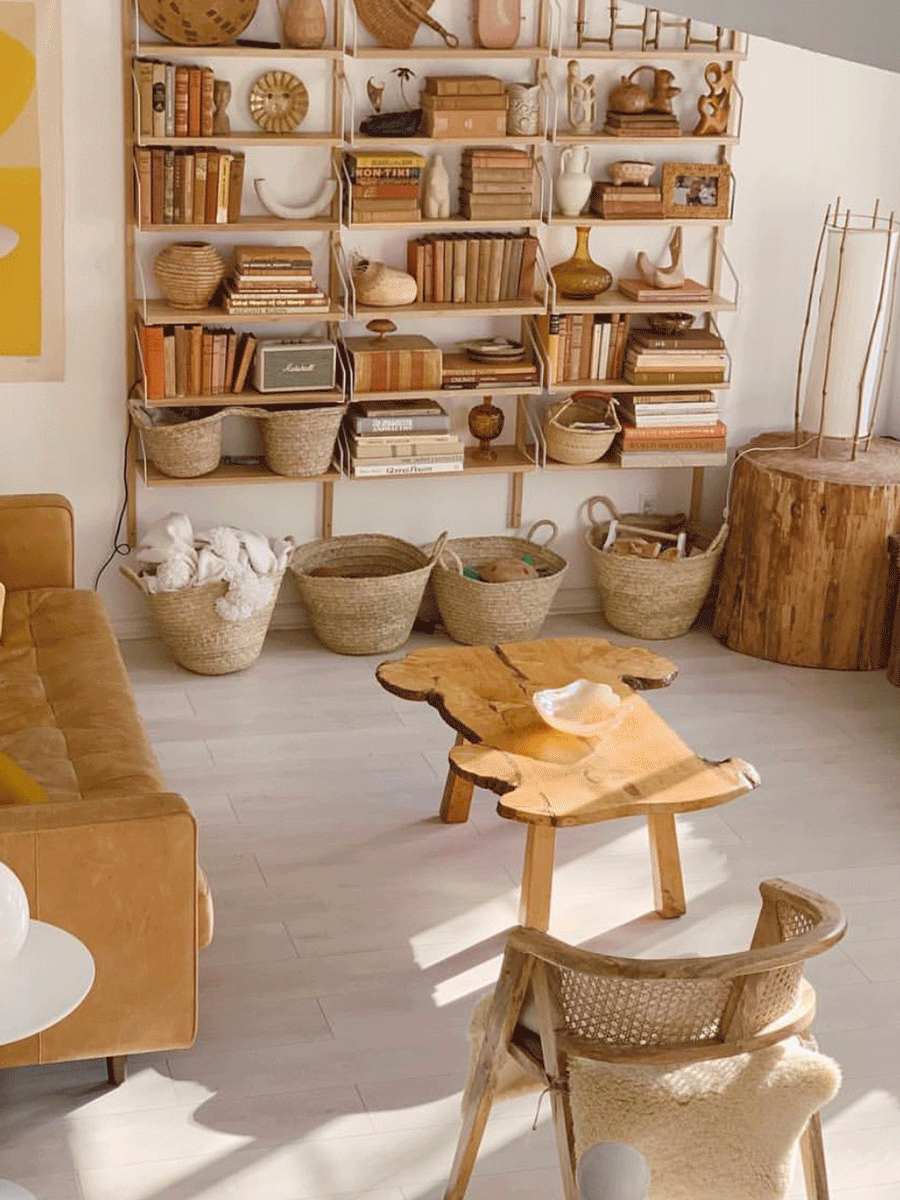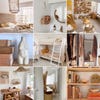How to Make Your Home Look Like a Perfectly Curated Instagram Feed
Lessons from the coolest vintage shop owner.
Published Oct 4, 2019 6:00 AM
We may earn revenue from the products available on this page and participate in affiliate programs.
Sarah Shabacon’s favorite item in her home is an old tree stump.
“My husband and I found [it] on my birthday a few years ago. It must have fallen off a lumber truck in the middle of the woods,” she says of the piece now seeking refuge in a corner of her living room. “After half a year of drying it out in our garage, we moved it into the house and it just adds this earthy vibe to the living room that reminds me of our adventures each time I look at it.”
Shabacon, the Vancouver-based owner of vintage shop Bohème Goods, took a similarly sentimental approach to designing the rest of her space. She and her husband bought their four-bedroom townhouse when she was 20 years old and pregnant after being enticed by its location on a cherry blossom–lined street and its abundance of natural light. Now, two children later, the family is still there, and the once-bare space is full of personal touches and vintage accents that make for a unique residence.
She chooses to surround herself with original items that broadly fall under the category of “art”; an old French sofa, for example, or a piece of driftwood that one of her sons found on the beach. Given that she owns a vintage shop, Shabacon has an eye for curating these one-of-a-kind pieces. She regularly scours Craigslist, thrift stores, and local boutiques, layering these secondhand finds with the occasional contemporary piece, though including the latter comes with intensive research and scrutiny.
“I avoid buying new items, but I do my research beforehand and ensure that when I do, it’s a well-made item that will last at least a generation or two,” explains Shabacon, who launched Bohème Goods in 2016. She uses the shop as a creative outlet, one which allows her to curate secondhand items and cultivate a loyal customer following. “It’s not a job but a passion that allows me to stay home with my sons to show them the world, all while reducing the effects fast fashion has on the environment.”
Enviable array of vintage aside, the most striking thing about Shabacon’s home may be the fact that every item looks tailor-made to fit the space. It’s like a perfectly curated Instagram feed brought to life: Natural materials, charming accents, and calming neutrals abound.
Being able to craft a space that flows so effortlessly and looks completely cohesive is a skill not many possess, and while it comes as second nature to Shabacon—“I’m naturally more drawn to textures and shades that evoke a peaceful state of mind, so I didn’t have to worry about anything matching,” she says—it’s a hard balance to strike for many. In the hopes of demystifying the process, we asked her to share her tips on designing a calming, uniform space. If your home could use a little more consistent tranquility, read on.
Think tonally
“When choosing your color palette for a space, start with the color that makes you feel the way you wish to feel in the space,” says Shabacon. For example, if you want an inspiring space for creating, she recommends white—the ultimate canvas for layering in textures and other found objects that inspire. Whichever color you go with, be sure to use similar tones throughout the space. This will allow you to incorporate patterns, as they, too, will fall under the same color scheme.
Create a textural buffet
While the color palette should be kept uniform, the textures should not. “Mix textures when you’re decorating,” advises the shop owner. Try a blend of natural materials like raw wood or earthy ceramics balanced out with antique brass for a layered look. Shabacon is also a fan of bringing in live texture through foliage or desert plants. Though be sure to avoid one material in particular: plastic. “Avoid plastic, not only for its lack of durability, but to be eco-friendly,” says Shabacon.
Compartmentalize
The reason most spaces steer from the path of cohesion is due to clutter. “Give everything a place of its own; if you want to keep your space looking and feeling peaceful, it’s crucial to stay on top of this,” says Shabacon. After doing a bit of KonMari-ing to pare down the unnecessary items, give everything else in your space a specific home. Grouping by function or by color will keep everything organized and looking stylish.
When in doubt, hide things
Shabacon is perfectly aware that real life doesn’t always fall perfectly into one color palette. The key to making it look like it does lies in design-forward storage. This is a tip that parents, in particular, will find useful: “Having kids doesn’t necessarily mean [having] floors covered in plastic toys and cartoon bedding,” she says. “When I decorated my sons’ bedroom, I made the basics neutral and simple. Their toys are in Amazonian baskets that are easy to access and easy to disguise, and nearly all their toys are made of wood or cloth.”
Decorate intentionally
If you think of yourself as the inspiration for your home, every piece you choose that’s true to your style will automatically be cohesive. Rather than stressing about finding a ton of items that follow the same design aesthetic, take your time filling your home with things that reflect your personality. “When a room is filled with objects that have meaning rather than [simply] match, you enter a whole new level of interior design. It should seem natural and express the habitants of the space rather than look like it’s staged for an open house,” councils Shabacon.
Also, don’t overdecorate in the name of sticking to a theme. “Try to keep from filling every blank space with something—this allows the space to breathe,” she continues. Be mindful in your placement of furniture throughout the space and focus on the areas you spent the most time in.
See more homes we love: The Founder of Edie Parker Invites Us Inside Her Technicolor Upper East Side Apartment This Founder’s Gorgeous LA Kitchen Is Just as Bright as Her Brand This Shoppable West Village Townhouse Will Blow You Away

